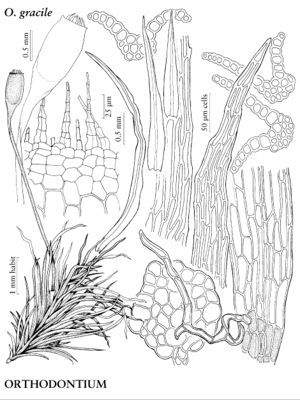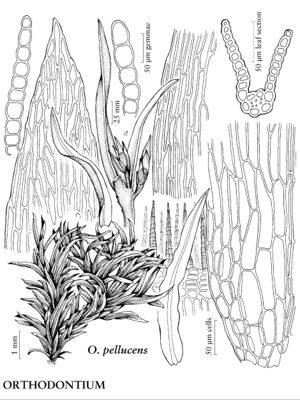Orthodontium
Sp. Musc. Frond. Suppl. 2(2,2): 123, plate 188. 1827.
| Taxon | Illustrator ⠉ | |
|---|---|---|
 | Orthodontium gracile | Patricia M. Eckel |
 | Orthodontium pellucens | Patricia M. Eckel |
Plants light yellow-green to yellowbrown, shiny or glossy. Stems to 2 cm, usually shorter, densely foliose, simple or 2-fid at base; central cylinder small; moderately radiculose from stem and leaf-bases, radicles hyaline to reddish, smooth, with oblique tangential walls. Leaves patent, erect-spreading when dry, spreading when moist, keeled or shallowly carinate; margins plane or partly broadly recurved; apex slender-acute; costa ending subapically or sometimes short-excurrent; alar cells equilateral to short-rectangular, redbrown, in 1 or 2 rows, somewhat smaller and thicker than laminal cells just distal; proximal laminal cells laxly oblong-hexagonal; medial cells linear to linear-rhomboidal; distal cells broader; apical cells short to long-rectangular. Seta yellowish, slender, erect-flexuose. Capsule symmetric, smooth when moist; exothecial cells pale-brown to yellowbrown; stomata phaneropore, in neck.
Distribution
Nearly worldwide, tropical and temperate regions
Discussion
Species 14 (2 in the flora).
Orthodontium was monographed by W. Meijer (1951) and treated in Mexico by H. A. Crum (1994d) and in Central America by B. H. Allen (2002). Leaves of Orthodontium have 1–2(–4) rows of brown cells at the insertion, which appear associated with rhizoid initials. A. E. Newton and N. E. Bell (2006) analyzed Orthodontium lineare and indicated that stems of Orthodontium may produce branch-axes from epidermal cells, including perichaetial, perigonial, and vegetative branch-axes. These branch-axes are attached to the stem by rhizoids and may produce innovations by small clusters of cells, one of which produces a short branch. The leaves are similar to those of some genera in Bryaceae, but that family generally has broader leaves and more rectangular to quadrate laminal cells.
Orthodontium may resemble species of Dicranaceae in the reddened, lax cells at the laminal insertion, but it differs in the smooth, evenly long-rectangular to linear cells, subserrulate apex, and narrow costa (D. H. Norris and J. R. Shevock 2004). The two species in the flora may represent a relict from the Tertiary flora (A. L. Andrews 1932). Populations of Orthodontium in pristine areas of coniferous forest in the flora area may be particularly vulnerable to habitat disturbance from logging.
Selected References
None.
Lower Taxa
Key
| 1 | Leaves narrowly setaceous, 0.1-0.2 mm wide mid leaf, flexuose distally when dry or moist; costal stereid cells absent; capsules subcylindric; exostome teeth smooth; operculum short- rostrate; stems with central strand absent. | Orthodontium gracile |
| 1 | Leaves broadly linear, 0.5 mm wide mid leaf, twisted once along leaf length when dry or moist; costal stereid cells present; capsules ovoid-pyriform (wider at or just beyond mid capsule); exostome teeth finely papillose; operculum long-rostrate; stems with central strand sometimes present. | Orthodontium pellucens |